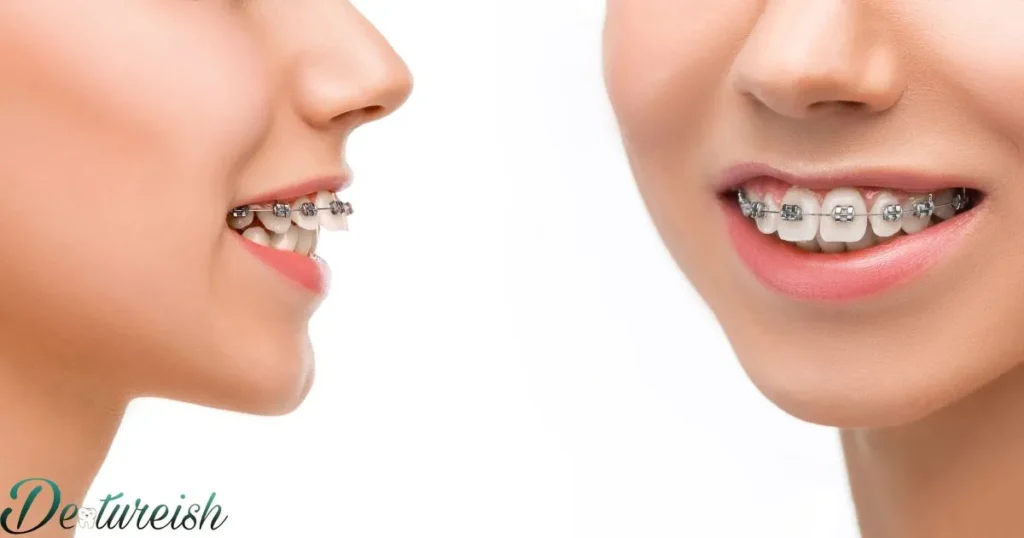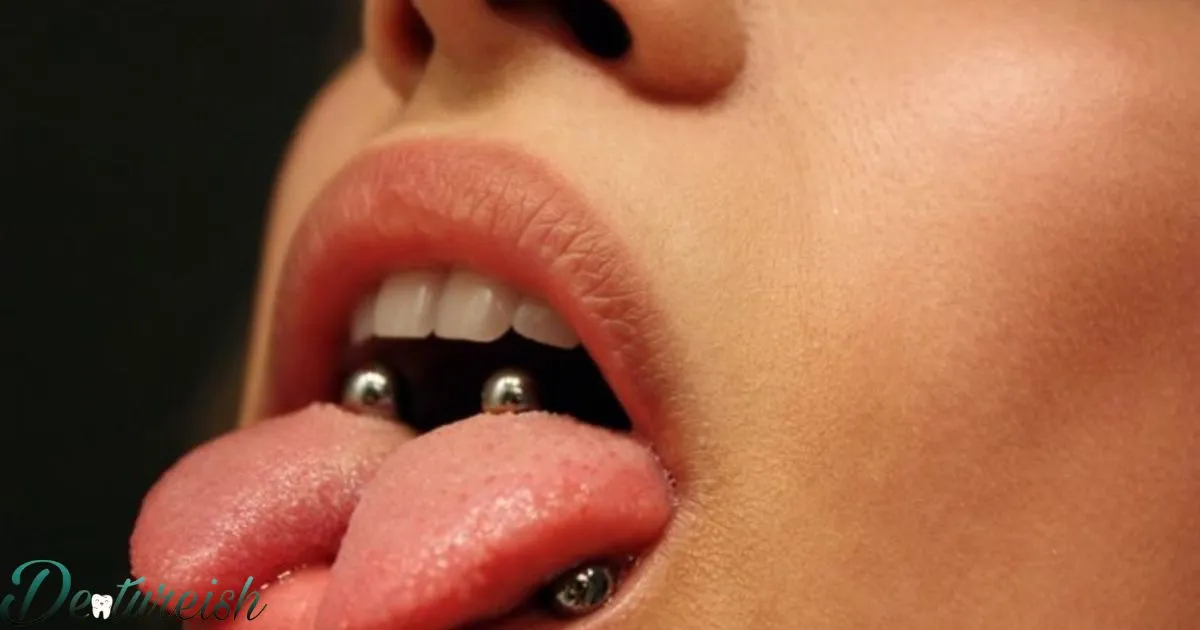Braces with a tongue piercing refer to having orthodontic braces when a tongue piercing is present. Braces help straighten and align teeth while a tongue piercing involves puncturing the tongue with a jewelry piece.
“Can You Get Braces With A Tongue Piercing?” This is a common question those considering braces may have if they also have their tongue pierced. They wonder if it is possible to have both treatments at the same time.
While it is technically possible to have braces and a tongue piercing, orthodontists may not recommend it. The tongue piercing jewellery could interfere with wearing rubber bands or other attachments as part of the brace treatment. It may also make brushing and flossing around the braces more difficult with the piercing. Proper oral hygiene is important during orthodontic treatment.
Braces Key Considerations
Getting braces involves straightening your teeth through the use of brackets, wires, and rubber bands or chains. It is an important decision to consider your options carefully. Braces treatment usually takes 12-24 months with regular adjustments to gradually move teeth into proper position. Be prepared for this long-term commitment of time and payments.
The orthodontist will create a treatment plan tailored just for you. They will examine your bite, tooth alignment, and jaw positioning to determine the best braces option. Different types include traditional metal braces, lingual braces behind teeth, or clear aligners. Discuss any concerns, goals for your smile, and finances to pick the treatment best for your situation.
Will A Tongue Piercing Interfere With Braces?
A tongue piercing could potentially cause issues when wearing braces. The jewelry may get caught on wires or brackets during eating, talking, and cleaning. This risks damage to the piercing or braces. It may also make flossing and keeping teeth clean more challenging with a new piercing. However, many orthodontists are comfortable doing both as long as extra care is taken of the piercing during treatment.
How Does A Tongue Piercing Work?
The tongue piercing involves placing a small barbell through the tongue flesh near the tip. One end has a bead and the other is usually internally threaded to easily change out jewelry. It takes 4-6 weeks to fully heal.
Swelling and some pain is common at first but improves quickly. Once healed, the piercing is a fun way to enhance facial expression and playfulness while kissing. Proper oral hygiene must continue around the new piercing site to avoid infection.
What Does Braces Treatment Involve?

Braces treatment involves regular visits to the orthodontist every 4-8 weeks. At each appointment, the orthodontist will tighten or replace rubber bands and wires as needed to gradually shift teeth into proper alignment.
You may need to switch to different types of wires, brackets or aligners throughout the process. Keeping teeth extremely clean between visits is crucial to avoid cavities, gum disease or stalling treatment progress. Expect some discomfort initially that reduces over time.
Can Both Be Done At The Same Time?
Getting braces and tongue piercing simultaneously is possible but requires extra caution. The orthodontist must be experienced handling patients with oral piercings. You’ll need to be extremely diligent about cleaning both the piercing site and braces to avoid infection risks.
Swelling from the new piercing may also temporarily make wearing braces uncomfortable. With close monitoring, Braces Removal Price both can usually be managed together if you’re committed to their care.
Are There Risks Of Infection?
Any oral piercing carries infection risks, especially initially while healing. Having braces also introduces more places for plaque and bacteria to accumulate. Together, the chance of infection may be slightly higher than with either alone.
Be vigilant about cleaning around brackets and the piercing multiple times daily. Watch for signs of redness, swelling, pain or pus and contact your orthodontist right away if these occur. Prescription antibiotics can treat most infections if caught early.
Choosing Between Braces And Piercing
For some patients, it’s best to have braces treatment completed before getting an oral piercing. This reduces infection risks and discomfort. You’ll have straight teeth fully before adding a tongue piercing. For others who already have a piercing, removing it for the duration of braces may be preferable. Discuss options thoroughly with your orthodontist and piercer to decide the timing that’s right for your individual situation and oral health goals.
Remove My Tongue Piercing For Braces
5 tips for removing a tongue piercing for braces treatment
- Remove it yourself. If the piercing is freshly healed and the jewelry is not too tight, you can generally remove it yourself by turning it anti-clockwise. Otherwise see your piercer.
- Clean the area. Use an antiseptic mouthwash after removal to clean the former piercing site and reduce risk of infection as it heals closed.
- Give it time to close. The hole will shrink and eventually close on its own, but it’s best to wait at least a few weeks before starting braces to allow proper healing.
- Consider placeholders. Some piercers may recommend clear plastic retainers or glass jewelry to help the hole stay open for easy repiercing later, once braces treatment ends.
- Work with your piercer. Schedule an appointment with the professional who originally did the piercing. They can ensure it’s removed smoothly and advise on low-risk healing and repiercing when braces treatment wraps up.
- Discuss with orthodontist. Be sure your orthodontist knows about any past oral piercings, even if removed, just in case of any related oral health concerns during treatment. Follow their care instructions closely.
- Wait to repierce. Most experts agree to let the site fully heal, such as 3-6 months after braces removal, before getting repierced to avoid potential issues like swelling or tenderness.
Consulting your piercer and orthodontist can help ensure a tongue piercing is safely and smoothly removed to accommodate the best possible braces treatment process and results. Proper aftercare helps prevent infection too.
When Should A Tongue Piercing Be Removed?
In general, a tongue piercing should be removed temporarily for certain dental procedures that could get tangled in or damaged by the jewelry, like adjustments with traditional braces. Removing it 2-4 weeks before braces placement gives swelling time to go down. It’s also best to wait until about 2 weeks after the last braces adjustment to get it repierced. This ensures any risk of infection from the recent dental work has fully passed before repiercing the still-healing tongue tissue.
Can I Get My Piercing Re-Done After Braces?
In most cases, yes your tongue piercing can safely be replaced once braces treatment is fully complete. Allow at least 2 weeks after removing braces for any lingering oral irritation or swelling to fully subside.
During this time, keep the piercing hole open with a small retainer to avoid closing. Then, your piercer can carefully reinsert appropriate jewelry through the established hole. Just be aware the piercing may take a few weeks longer than usual to heal fully the second time around. But it’s very possible to repierce after straight teeth.
What Are The Benefits Of Removing It?
Some benefits of temporarily removing a tongue piercing for braces include: lower infection risk during treatment, less chance of the jewelry snagging on wires/brackets, more comfortable wearing aligners or elastics, and improved ability to thoroughly clean both areas.
It also allows braces adjustments without worrying about damaging the piercing. Once braces are done, enjoying pierced selfies with your new straight smile is even better knowing no distractions occurred along the way! Overall it can help braces work smoothly and avoid issues.
Asking Your Orthodontist For Advice
You should schedule an appointment with your orthodontist to get their input on how a tongue piercing may impact braces treatment. At the appointment, ask the orthodontist if keeping the piercing in place could interfere with aligning your teeth or prolong treatment. They can examine your mouth and teeth to determine if the piercing would pose any issues.
What Will An Orthontist Say About My Piercing & Braces Question?
The orthodontist will evaluate how the placement of your piercing relates to where braces need to be attached in your mouth. They may advise removing the piercing during treatment since it could get in the way or interfere with the movements needed to straighten your teeth. Keeping it in may increase risk of infection or damage to braces equipment over time.
How Can An Orthodontist Help?
An orthodontist can examine your specific case and recommend the best treatment plan to straighten your teeth. They may suggest alternatives to braces like clear aligners if you want to keep the piercing. Or discuss removing and repiercing options after treatment ends. An orthodontist is trained to create a customized plan around your individual needs and concerns.
Will An Orthodontist Remove My Piercing?
An orthodontist will not remove a piercing for you. As a dental professional, they focus on treating teeth and bite issues, not piercings. The orthodontist can only advise if removing the piercing themselves or having a piercer remove it would be necessary for orthodontic treatment to proceed safely and effectively.
Can I Get Their Recommendation In Writing?
It’s reasonable to ask the orthodontist for their recommendation regarding your piercing and braces in writing. Getting their advice in a letter allows you to review their opinion at your convenience and also have documentation of any potential issues or alternatives discussed.
What Alternatives Might They Suggest?
The orthodontist may suggest clear aligners like Invisalign if you want to keep the piercing. Aligners are removable, so the area is accessible for regular piercer cleanings. Orthodontic devices bonded to the back of teeth may also be an option. The goal would be finding a treatment that doesn’t require braces directly on the front teeth near the piercing.
Other Ways To Straighten Teeth
Even if braces are not advisable with a tongue piercing, orthodontists have other straightened teeth options that could work for your situation. Clear aligners and less visible orthodontic appliances often provide alternatives to traditional metal braces.
Are There Braces Alternatives If I Keep My Tongue Piercing?
Yes, if you want to keep a tongue piercing, your orthodontist may suggest clear aligner treatment using a system like Invisalign as an alternative to braces. Aligners are removable, so the area around the piercing would be fully accessible for cleanings. This could help avoid potential issues from a fixed wire or bracket being too close to the piercing site.
What Is Invisalign Treatment?
Invisalign uses a series of nearly invisible, removable plastic aligners to gradually move teeth into the desired position. Aligners are custom-made to fit your individual mouth and are replaced every 1-2 weeks as teeth move. Since they come off to eat and clean, Invisalign may allow for ongoing tongue piercing care during orthodontic treatment.
Are Clear Aligners An Option For Me?
Whether clear aligners are a good fit for your specific case depends on the type and degree of teeth alignment needed. Most orthodontists find aligners appropriate for correcting minor to moderate teeth crowding and gap closure. They may not work as well for more extensive bite or jaw adjustments. An evaluation can determine if aligners meet your treatment objectives.
Are There Other Clear Aligner Systems?
In addition to Invisalign, other popular clear aligner system options include ClearCorrect, SnapCorrect, and ClearPath. While various manufacturers have different features, the basic principle is the same – using a series of clear, removable trays to shift teeth positions gradually over time. An orthodontist can help compare options and choose the best clear aligner system for your unique treatment needs and schedule.
What About Remote Orthodontic Treatments?
Remote clear aligner therapy administered entirely via teledentistry is now an option with some orthodontists and aligner companies. A dentist performs a scan or sends impressions, and treatment is planned and monitored remotely through an app with limited office visits. This could potentially work for some patients who want clear aligners but have concerns over frequently visiting the orthodontist’s office.
Making The Right Choice For Your Situation

When considering braces vs keeping a piercing, it’s important to weigh your orthodontic needs and timelines with your preferences. An orthodontist consult can help you understand all factors to select the most suitable treatment path.
How Do I Decide Between Braces And My Tongue Piercing?
If you have a tongue piercing and need orthodontic treatment, you’ll need to choose between keeping your piercing or getting braces. Consider these key factors:
| Factor | Braces | Tongue Piercing |
| Orthodontic Needs | Braces can treat most teeth issues effectively. But may not work for severe cases. | Effectiveness of aligners may be limited for complex treatments. |
| Piercing Importance | Removing piercing even temporarily isn’t ideal. | Keeping your piercing is a higher priority. |
| Treatment Length | Braces often done in 1-2 years but could be longer. | Aligners with a piercing may take more time to see results. |
| Cost | Braces usually covered by insurance with set fees. | You’d need to repierce after braces. Aligners tend to cost more overall. |
| Comfort | Wires can be uncomfortable at times. | Aligners are removable for eating, cleaning and keeping piercing accessible. |
To decide, weigh your specific dental needs, timelines, priorities and preferences. Also consider each option’s pros and cons for your situation. Consulting an orthodontist is important to get a treatment plan tailored for you. Their expert opinion can help you choose what’s best for your teeth and tongue piercing goals. The right choice depends on balancing all factors involved.
What Are My Top Priority Needs?
Are your top priorities having your teeth straightened in the shortest time, keeping your piercing, avoiding metal braces, or reducing costs? Thinking through which factors matter most to you can guide your decision process when an orthodontist outlines the different treatment routes and expected outcomes.
How Long Will I Have Braces?
Treatment length depends on your individual case but most orthodontic work takes 9-24 months. Clear aligners may take longer in some cases. Knowing anticipated timelines can affect your choice to remove a piercing temporarily or pursue alternative options. Ask your orthodontist for a timeline projection based on your teeth.
Can I Wait To Repierce After Braces Treatment?
It’s generally possible to repierce a tongue after orthodontic treatment has ended. However, swelling and soreness when repiercing so soon after removing braces or aligners could possibly occur. Letting your mouth fully heal first, such as waiting 3-6 months after braces removal, may lead to less discomfort when repiercing.
When Should I Schedule An Evaluation?
Ideally, you should schedule an orthodontic evaluation appointment 4-6 months before you intend to start treatment. This allows adequate time for the orthodontist to examine your case, design a customized plan, and order any necessary orthodontic devices before the planned start date. Don’t wait until the last minute to consult an expert.
Frequently Asked Question
Will A Tongue Piercing Interfere With Braces Treatment?
A tongue piercing near the site where braces are placed could potentially snag on wires or brackets and interfere with the movements needed to align teeth.
Can I Keep My Tongue Piercing In While Wearing Braces?
Most orthodontists recommend removing tongue piercings temporarily during braces treatment due to the risks of infection, irritation or damage to equipment.
Are There Any Alternatives To Braces That Allow Keeping My Piercing?
Clear aligner systems like Invisalign may be a safer option as aligners are removable, avoiding fixed wires pressing on the piercing site.
Should I Remove My Piercing Myself Or See A Piercer?
For a safely and smoothly removed piercing, it’s best to visit the professional who originally did the piercing for guidance on removal and future repiercing.
How Long Do I Need To Wait To Get My Tongue Repierced After Braces?
Allowing the site to fully heal, such as 3-6 months after braces removal, lessens the chances of swelling or soreness with repiercing compared to sooner.
Conclusion
It is generally not recommended to get a tongue piercing while still wearing braces. The major risks include potential damage to the braces, oral hygiene issues that could slow treatment, and higher chances of infection from trauma to the fresh piercing getting caught on wires or brackets. Most orthodontists will advise removing any oral piercings before starting braces treatment.
It is best to wait until braces have been fully removed and sufficient time has passed for healing before considering getting a tongue re pierced. Braces treatment involves realignment of teeth and movement of jaws over several months, so any oral piercings could negatively impact the intended movements and slow down the treatment process.

